Fracasos necesarios / Necessary failures
Beca Grants & Commissions de la fundacion Cisneros Fontanals / CIFO Grants & Commissions Program 2017. Miami, Florida.
La necesidad de progreso ha estado ligada indudablemente a la estupidez. La historia se ha encargado de hacernos ver que, para avanzar un paso, debemos retroceder un par. Como especie, cada día tratamos de elevar nuestra sociedad a un nivel superior, sin embargo, las buenas intenciones no siempre bastan y es nuestra misma condición humana la que nos arrastra al error.
Este proyecto busca poner en evidencia una serie de invenciones creadas durante el siglo XX, que pretendieron ser en su momento una flamante visión del futuro. Lo curioso es que muchos de estos artefactos no son más que ridículos ideas que parecen sacadas de un mundo surreal y casi absorto en la demencia.
------------------------------------------------------------------------------------------
This project wants to highlight a series of inventions created during the twentieth century, which were intended to be the beginning of the future. The funny thing is that many of these inventions are nothing more than ridiculous artifacts that seem taken from a surreal world and almost absorbed in dementia. But despite the absurdity of the situations, these resounding failures opened the possibility of thinking about the thousand objects that today make our lives easier.
CONTENIDO / CONTENT:
1. Dibujos / Drawings.
2. Replicas/ Objects.
3.Exhibición/ Display.
3.Exhibición/ Display.
1. Dibujos / Drawings.
Lápiz, tinta y máquina de escribir sobre papel y papel encontrado / Pencil, ink and typewriter on paper and found paper.
73 x 36 cm
2017.

Casco Aislador / Isolator helmet . 1926.
Cansado de las constantes fiestas de su vecino, el reconocido inventor Ronald Mayers creo el casco aislador.
Al eliminar todo rastro de ruidos y distracciones externas, el casco permitía la plena concentración del usuario. Escribir una carta, leer un libro o hacer los deberes escolares son solo algunas de las tareas que resultarían más sencillas al contar con silencio absoluto.
La noche antes de la presentación oficial del casco en la feria de nuevos inventos de Nueva york, Ronald decidió conciliar el sueño con la ayuda del casco. Para su mala suerte la efectividad del casco evito que notara que su casa estaba siendo asaltada, perdiendo la caja fuerte que contenía los ahorros de su vida y documentos importantes de diversas investigaciones.
En la ruina y con prácticamente ningún éxito en las ventas del casco aislador, Ronald cayo en el alcoholismo durante años. Murió al sufrir una caída en su casa golpeándose la cabeza con el lavamanos del baño.
--------------------------
Tired of the constant festivities of his neighbor, the renowned inventor Ronald Mayers created the insulating helmet.
By eliminating all traces of noise and external distractions, the helmet allowed full user concentration. Writing a letter, reading a book or doing homework are just some of the tasks that would be easier to have absolute silence.
The night before the official presentation of the helmet at the new york invention fair, Ronald decided to sleep with the help of the helmet. To his bad luck, the effectiveness of the helmet prevented him from noticing that his house was being assaulted, losing the safe that contained his life savings and important documents of various investigations.
In the ruin and with virtually no success in the sales of the insulating helmet, Ronald fell into alcoholism for years. He died suffering a fall at home hitting his head with the sink in the bathroom.

Antena telepática / Thelepathic Antenna. 1919.
El doctor colombiano José María Gómez Jaramillo estaba convencido de que había desarrollado un mecanismo definitivo para el empleo eficaz de la telepatía.
Rechazado por la comunidad médica ante la idea de incrustar una antena metálica en el cráneo, pero sobre todo por la comprobada inexistencia de la telepatía, el doctor Gómez decidió demostrar la seguridad de su argumento instalando la antena en su propia cabeza.
Anestesiándose parciamente con éter y ungiendo su cabeza en cocaína procedió a clavar la antena en la parte posterior de su cráneo.
La única fotografía conocida del procedimiento fue tomada 16 minutos de la cirugía. 2 horas después el doctor Gómez falleció.
--------------------------------
The Colombian doctor José María Gómez Jaramillo was convinced that he had developed a definitive mechanism for the effective use of telepathy.
Rejected by the medical community to the idea of embedding a metal antenna in the skull, but especially for the proven absence of telepathy, Dr. Gómez decided to demonstrate the security of his argument by installing the antenna in his own head.
Anaesthetizing partially with ether and anointing his head in cocaine proceeded to drive the antenna into the back of his skull.
The only known photograph of the procedure was taken 16 minutes after surgery. 2 hours later, Dr. Gómez passed away.

“Color 3000”. 1951.
Elsa Butler, una famosa cosmetóloga de Hollywood patento una maquina capaz de teñir el cabello en tan solo 1 hora y sin necesidad de asistencia humana.En tan solo 6 meses desde su lanzamiento el 73% de los salones de belleza norteamericanos contaban con la fabulosa “Color 3000”.
Un año después de su puesta a la venta, las mujeres que usaron el dispositivo comenzaron a tener una caída constante de su cabello, llegando a reportarse casos de alopecia irreversible en aproximadamente 6000 mujeres.
Cuando las autoridades buscaron la respuesta de Butler fue demasiado tarde. La mujer había abandonado el país con una suma de dinero no calculada, pero presumiblemente de alto valor.
10 años después Elsa Butler fue arrestada en Alemania cuando pretendía vender una nueva versión de la máquina a un importante fabricante de productos cosméticos.
-----------------------------------
Elsa Butler, a famous Hollywood cosmetologist patented a machine capable of dyeing hair in just 1 hour and without the need for human assistance.
In just 6 months since its launch, 73% of North American beauty salons had the fabulous "Color 3000".One year after its sale, the women who used the device began to have a constant fall of their hair, reporting cases of irreversible alopecia in approximately 6000 women.
In just 6 months since its launch, 73% of North American beauty salons had the fabulous "Color 3000".One year after its sale, the women who used the device began to have a constant fall of their hair, reporting cases of irreversible alopecia in approximately 6000 women.
When the authorities sought Butler's response, it was too late. The woman had left the country with a sum of money not calculated, but presumably of high value.10 years later Elsa Butler was arrested in Germany when she intended to sell a new version of the machine to a leading manufacturer of cosmetic products.

Sombrero radio / Radio hat .1932.
El sombrero radio fue rápidamente censurado por las posibles repercusiones sobre su uso, por ejemplo:
1. Molestias publicas generadas por el ruido.
2. Atracción de rayos (Poco probable).
3. Captación ilegal de conversaciones privadas o gubernamentales.
4. incomodidad al cruzar puertas o permanecer en lugares cerrados.
5. Electrocución.
6. electrocutar a terceros.
7. incendio
2. Atracción de rayos (Poco probable).
3. Captación ilegal de conversaciones privadas o gubernamentales.
4. incomodidad al cruzar puertas o permanecer en lugares cerrados.
5. Electrocución.
6. electrocutar a terceros.
7. incendio
---------------------
The radio hat was quickly censored for the possible repercussions on its use, for example:
1. Public nuisances generated by noise.
2. Lightning attraction (Unlikely).
3. Illegal capture of private or governmental conversations.
4. discomfort when crossing doors or staying in closed places.
5. Electrocution.
6. electrocute third parties.
7. fire
2. Lightning attraction (Unlikely).
3. Illegal capture of private or governmental conversations.
4. discomfort when crossing doors or staying in closed places.
5. Electrocution.
6. electrocute third parties.
7. fire
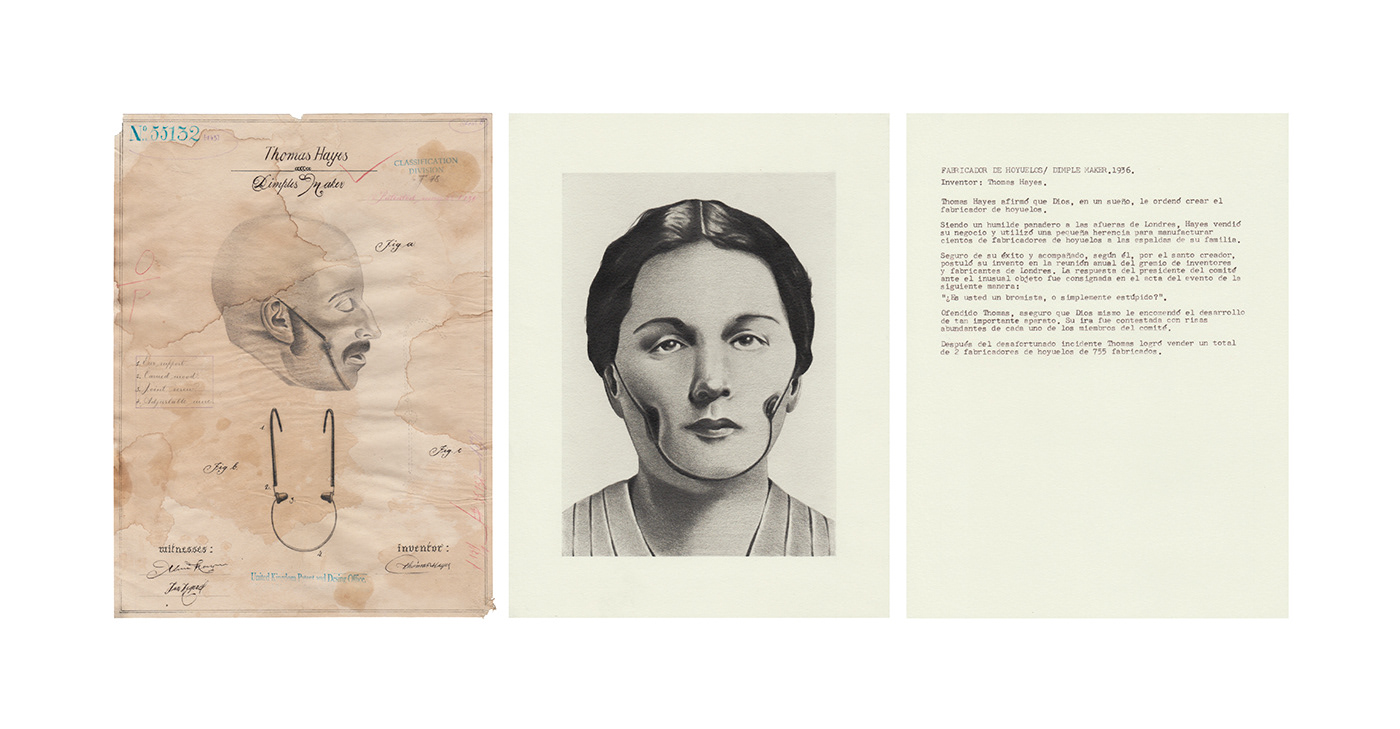
Fabricador de Hoyuelos / Dimple maker. 1936.
Thomas Hyde afirmó que Dios, en un sueño, le ordenó crear el fabricador de hoyuelos. Siendo un humilde panadero a las afueras de Londres, Hayes vendió su negocio y utilizó una pequeña herencia para manufacturar cientos de fabricadores de hoyuelos a las espaldas de su familia.
Seguro de su éxito y acompañado, según él, por el santo creador, postuló su invento en la reunión anual del gremio inventores y fabricantes de Londres. La respuesta del presidente del comité ante el inusual objeto fue consignada en el acta del evento de la siguiente manera:
“¿Es usted un bromista, o simplemente estúpido?”. Ofendido Thomas, aseguro que Dios mismo le encomendó el desarrollo de tan importante aparato. Su ira fue contestada con risas abundantes de cada uno de los miembros del comité.
Después del desafortunado incidente Hayes logro vender un total de 2 Fabricadores de hoyuelos de 755 fabricados.
----------------------
Thomas Hyde affirmed that God, in a dream, ordered him to create the dimple maker.A humble baker outside of London, Hayes sold his business and used a small inheritance to manufacture hundreds of dimple makers behind his family's back.
Sure of his success and accompanied, according to him, by the holy creator, he postulated his invention at the annual meeting of the guild inventors and manufacturers of London. The response of the chairman of the committee to the unusual object was recorded in the tro register of the event as follows: "Are you a joker, or just stupid?".Offended Thomas, assure that God himself entrusted the development of such an important device. His anger was answered with abundant laughter from each member of the committee.
After the unfortunate incident Hayes managed to sell a total of 2 dimple fabricators of 755 manufactured.
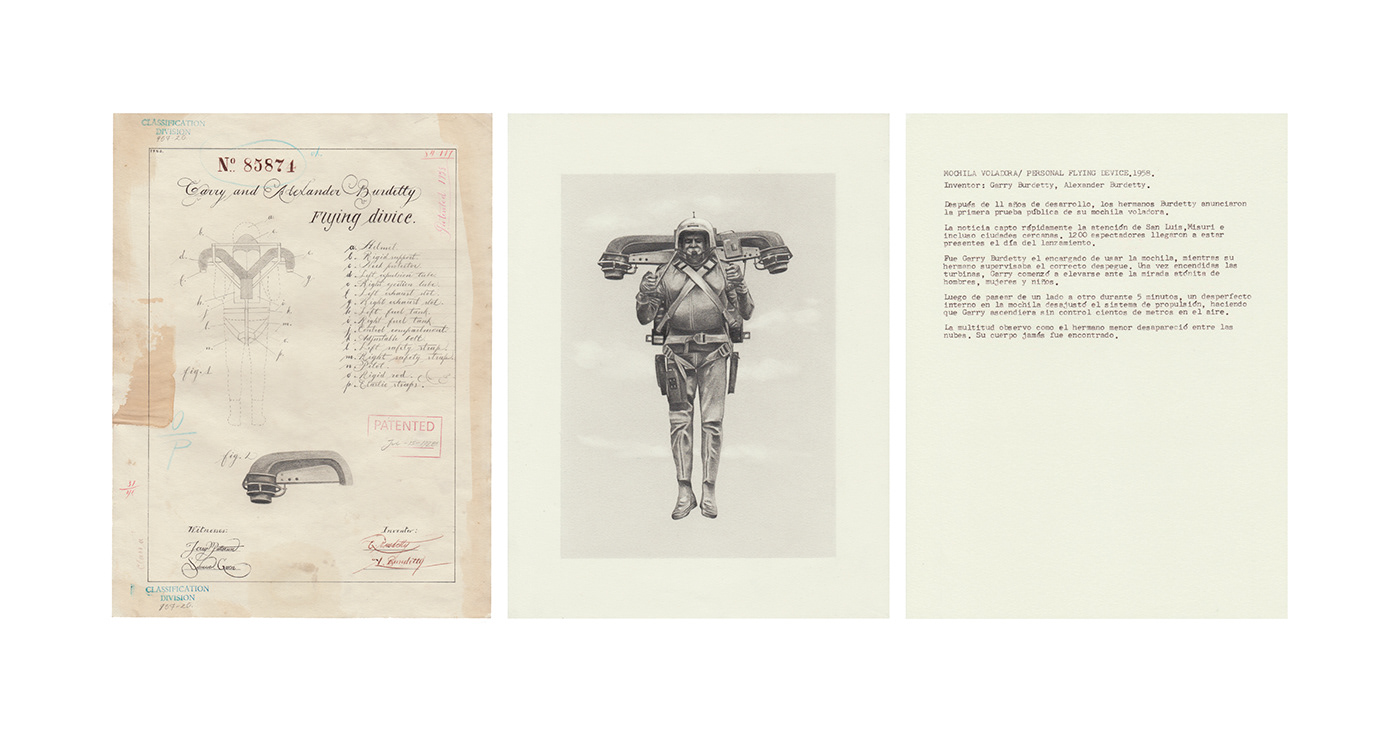
Mochila voladora / Personal flying device. 1958.
Después de 11 años de desarrollo, los hermanos Burdetty anunciaron la primera prueba pública de su mochila voladora. La noticia capto rápidamente la atención de San Luis, Misuri su ciudad natal, e incluso de estados cercanos. 1200 espectadores llegaron a estar presentes el día del lanzamiento.
Fue Garry Burdetty el encargado de usar la mochila, mientras su hermano Alexander supervisaba el correcto despegue.
Una vez encendidas las turbinas, Garry comenzó a elevarse ante la mirada atónita de hombres, mujeres y niños. Luego de volar de un lado a otro durante 5 minutos, un desperfecto interno en la mochila desajustó el sistema de propulsión, haciendo que Garry se elevara sin control cientos de metros en el aire. La multitud observo como el hermano menor desapareció entre las nubes. Su cuerpo jamás fue encontrado.
-----------------
After 11 years of development, the Burdetty brothers announced the first public test of their flying backpack. The news quickly caught the attention of St. Louis, Missouri, his hometown, and even nearby states. 1200 spectators were present on the day of the launch.
Garry Burdetty was in charge of using the backpack, while his brother Alexander supervised the correct take-off.
Once the turbines were turned on, Garry began to rise before the astonished gaze of men, women and children. After flying from one side to another for 5 minutes, an internal flaw in the backpack unsettled the propulsion system, causing Garry to rise uncontrollably hundreds of meters into the air. The crowd watched as the younger brother disappeared into the clouds. His body was never found.

Televisón personal / Personal television. 1963.
La televisión personal fue un éxito inmediato, vendiendo cerca de 4000 unidades en su primera semana.
El 13 de mayo de 1964 un dispositivo usado por un joven de 17 años estallo en Glenwood Springs, Colorado. El joven sufrió quemaduras de segundo grado y ceguera permanente en uno de sus ojos. Días después del incidente la fabricación del artefacto fue descontinuada.
--------------------
Personal television was an immediate success, selling close to 4,000 units in its first week.
On May 13, 1964, a device used by a 17-year-old boy exploded in Glenwood Springs, Colorado. The young man suffered second degree burns and permanent blindness in one of his eyes. Days after the incident, the manufacture of the device was discontinued.
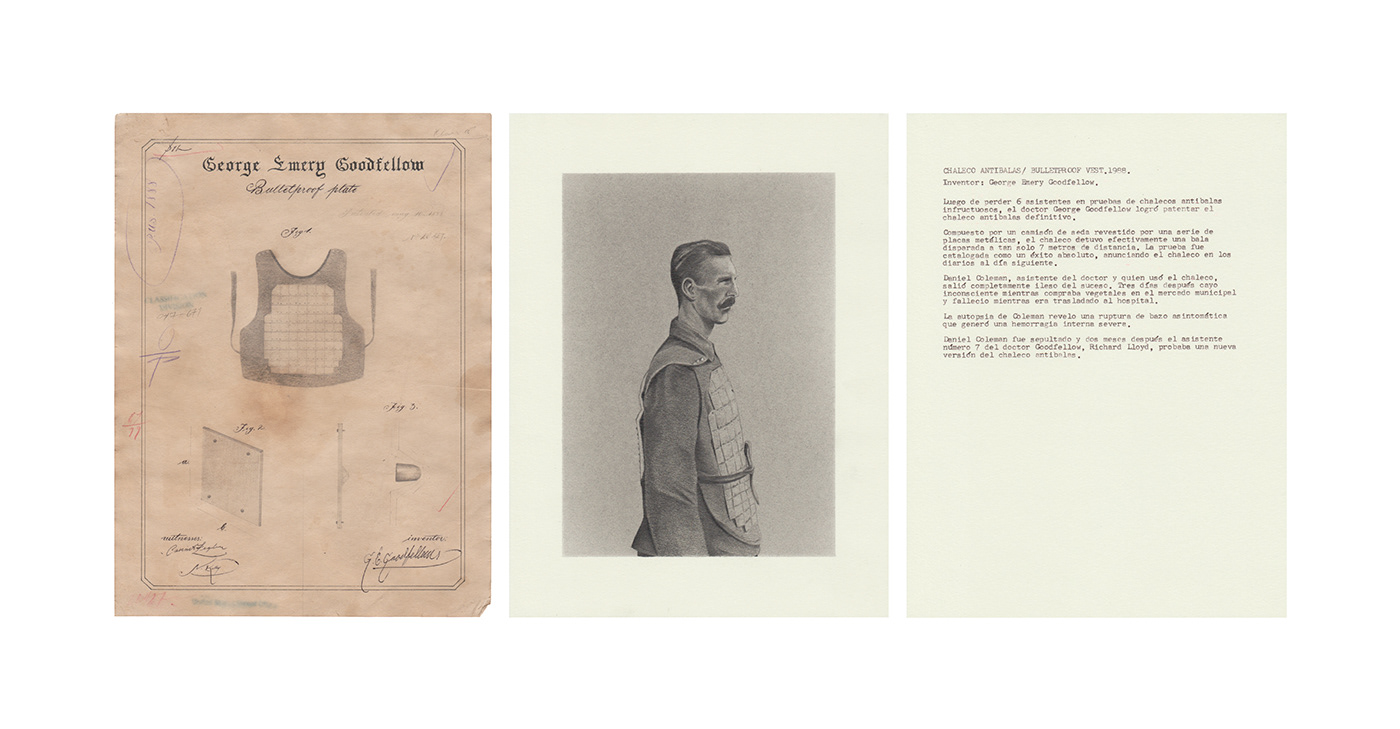
Chaleco antibalas / Bulletproof vest. 1988.
Luego de perder 6 asistentes en pruebas de chalecos antibalas infructuosas, el doctor George Goodfellow logro patentar el chaleco antibalas definitivo.
Compuesto por un camisón de seda revestido por una serie de placas metálicas, el chaleco detuvo efectivamente una bala dispara a tan solo 7 metros de distancia. La prueba fue catalogada como un éxito absoluto, anunciando el chaleco en los diarios al día siguiente. Daniel Coleman, asistente del doctor y quien usó el chaleco, salió completamente ileso del suceso. Tres días después cayo inconsciente mientras compraba vegetales en el mercado municipal y falleció mientras era trasladado al hospital.
La autopsia de Coleman revelo una ruptura de bazo asintomática que genero una hemorragia interna severa.
Daniel Coleman fue sepultado y dos meses después el asistente número 7 del doctor George Goodfellow, Richard Lloyd, probaba una nueva versión del chaleco antibalas.
-------------------------------------
After losing 6 attendees in evidence of unsuccessful bulletproof vests, Dr. George Goodfellow managed to patent the ultimate bulletproof vest.
Composed of a silk nightgown covered by a series of metal plates, the vest effectively stopped a bullet firing just 7 meters away. The test was cataloged as an absolute success, announcing the vest in the newspapers the next day. Daniel Coleman, assistant doctor and who wore the vest, was completely unharmed. Three days later he fell unconscious while buying vegetables at the municipal market and died while being transferred to the hospital.
The autopsy of Coleman revealed an asymptomatic rupture of the spleen that caused a severe internal hemorrhage.
Daniel Coleman was buried and two months later the assistant number 7 of Dr. George Goodfellow, Richard Lloyd, was trying out a new version of the bulletproof vest.

Máscara cono / Beauty protector. 1939.
Creada para proteger el maquillaje de las damas contra épocas de lluvia o nieve, la máscara cono supuso el siguiente paso en la moda femenina.
Luego de un ligero éxito apadrinado por la curiosidad del artefacto, las compradoras comenzaron a experimentar problemas para percibir la profundidad al caminar, además de la innecesaria incomodidad para llevar a cabo una simple conversación.
La prohibición total del invento sucedió justo cuando una de las usuarias de la máscara, en medio de una fuerte nevada, fue atropellada por un automóvil al cruzar una calle en el centro de Vancouver. La causa del accidente fu atribuida a la poca visibilidad de la tormenta, sumada a la producida por la máscara.
Evelyn Tremblay, su creadora, fue consumida por una serie de demandas cada vez más costosas. En 1941 fue hallada muerta en su residencia. El dictamen oficial evidencio suicidio por envenenamiento. No se encontró en su casa ninguna relación con la máscara cono.
---------------------
Created to protect ladies' makeup against rain or snow, the cone mask was the next step in women's fashion. After a slight success sponsored by the curiosity of the artifact, the buyers began to experience problems to perceive the depth of walking, in addition to the unnecessary discomfort to carry out a simple conversation.
The total ban of the invention happened just when one of the users of the mask, in the middle of a heavy snowfall, was hit by a car crossing a street in downtown Vancouver. The cause of the accident was attributed to the poor visibility of thestorm and the mask.
Evelyn Tremblay was consumed by a series of increasingly expensive demands. In 1941 she was found dead in her residence. The official opinion showed suicide by poisoning. No relationship with the cone mask was found in his house.

Traje vulcanizado de vuelo / Vulcanized flight suit. 1935.
El coronel e ingeniero del ejército español Emilio Lacer diseño el traje para ser utilizado en un vuelo que alcanzaría por primera vez la estratosfera del planeta. El traje fue confeccionado a partir de seda vulcanizada y un casco de metal denso totalmente presurizado.
El día del vuelo Lacer se percató que su invento había sido extraído de su residencia sin ningún tipo de rastro o certeza de su paradero. Lacer fue llamado a servir en el bando republicano al comenzar la guerra civil española y jamás intentó retomar la construcción del caparazón.
15 años después, un sujeto llamado Luis Eduardo Almeida presento una versión del traje Vulcanizado. Almeida jamás recibió apoyo económico para efectuar el vuelo de prueba debido a los rotundos fallos de diseño exhibidos en el traje, además de no poseer conocimiento total sobre su supuesta invención.
-----------------------
Colonel and engineer of the Spanish army Emilio Lacer designed the suit to be used in a flight that would reach the planet's stratosphere for the first time. The suit was made from vulcanized silk and a fully pressurized dense metal helmet.
On the day of the flight Lacer realized that his invention had been extracted from his residence without any trace or certainty of his whereabouts. Lacer was called to serve in the republican side at the beginning of the Spanish civil war and never tried to resume the construction of the shell.
15 years later, a subject named Luis Eduardo Almeida presented a version of the Vulcanized suit. Almeida never received financial support to carry out the test flight due to the outright design flaws exhibited in the suit, in addition to not having full knowledge about his alleged invention.
2. Replicas 1:1, tamaño real / Objects. 1:1 size replicas.


Casco aislador / Isolator helmet.
Plástico, fieltro, cobre, acetato, cuero / Plastic, felt, copper, acetate, leather.
35 x 26 x 29 cm. Aprox.
2017.




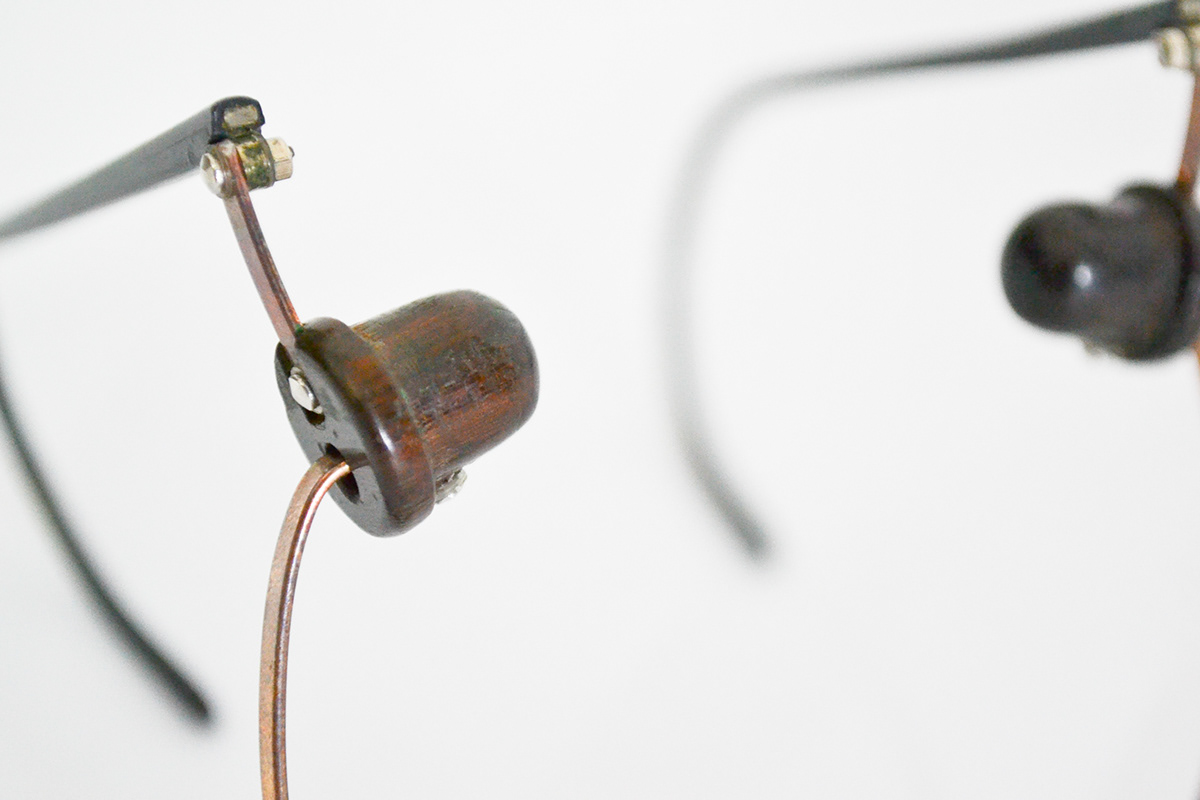

Fabricador de hoyuelos / Dimple maker.
Plástico, Cobre, madera / Plastic, copper, wood.
17,5 x 7,5 cm.
2017.
17,5 x 7,5 cm.
2017.



Antena telepática / Telephatic antenna.
Acero, plata, vidrio, cuero, hierro, cobre / Steel, silver, glass, leather, iron, copper.
54 x 29 x 7,5 cm. (variable).
2017.
54 x 29 x 7,5 cm. (variable).
2017.




Máscara cono / Cone mask.
Acetato, tornillos metálicos y cuero / Acetate, metal screws and leather.
17,5 x 39 x 14,5 cm. Aprox.
2017
17,5 x 39 x 14,5 cm. Aprox.
2017
3. Exhibición en las instalaciones de la fundación Cisneros Fonstanals (CIFO).
Display at the Cisneros Fontanals Art Fundation (CIFO) Facilities.
Miami, Florida.







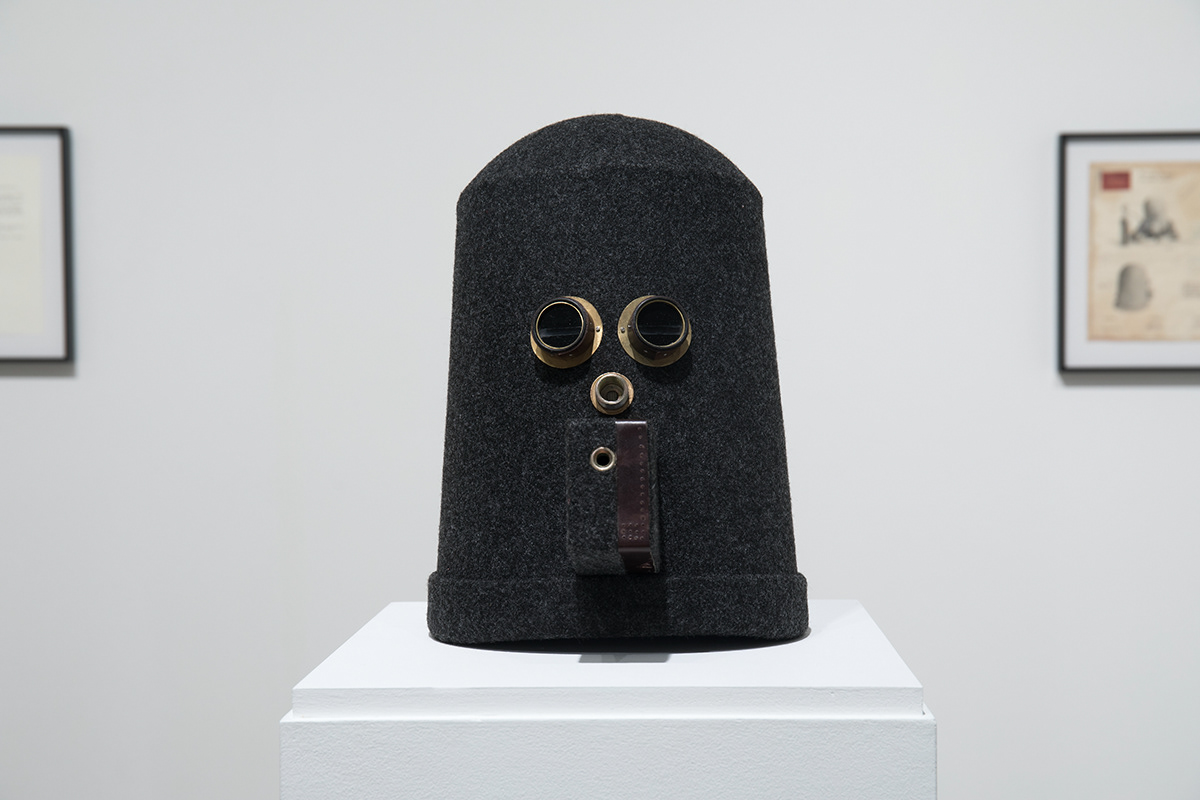






Muchas gracia por llegar hasta el final / Thanks a lot for see the entire project.
Espero fuera de su agrado / Hope you like it.


